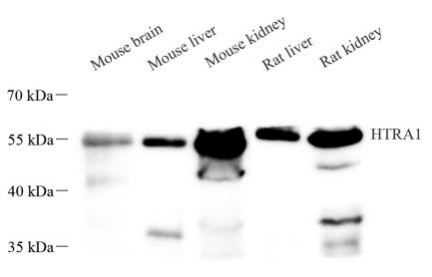Anti-htrA1 Rabbit pAb (100 μl)
| Reactivity: | M,R |
| Applications: | WB |
| Host Species: | Rabbit |
| Clonality: | Polyclonal |
| Gene Name: | Serine protease HTRA1 |
Synonyms: | ARMD7, High-temperature requirement A serine peptidase 1, HtrA, HtrA serine peptidase 1, HTRA1, L56, ORF480 |
Immunogen: | Recombinant protein corresponding to Mouse HTRA1 |
Uniprot ID: | Q9R118 |
Isotype: | IgG |
Purity: | Affinity purification |
Predicted MW. / Observed MW. | 51 kDa / 55 kDa |
Product Usage Information
WB | Mouse, Rat | 1: 1000-1: 2000 | brain, liver, kidney |
Background
Serine protease with a variety of targets, including extracellular matrix proteins such as fibronectin. HTRA1-generated fibronectin fragments further induce synovial cells to up-regulate MMP1 and MMP3 production. May also degrade proteoglycans, such as aggrecan, decorin and fibromodulin. Through cleavage of proteoglycans, may release soluble FGF-glycosaminoglycan complexes that promote the range and intensity of FGF signals in the extracellular space. Regulates the availability of insulin-like growth factors (IGFs) by cleaving IGF-binding proteins. Inhibits signaling mediated by TGF-beta family members. This activity requires the integrity of the catalytic site, but it is unclear whether it leads to the proteolytic degradation of TGF-beta proteins themselves or not . By acting on TGF-beta signaling, may regulate many physiological processes, including retinal angiogenesis and neuronal survival and maturation during development. Intracellularly, degrades TSC2, leading to the activation of TSC2 downstream targets.
Images
| Western blot analysis of HTRA1 (GB114378) at dilution of 1: 1000 |
Storage
| Storage | Store at -20°C for one year. Avoid repeated freeze/thaw cycles. |
| Storage Buffer | PBS with 0.02%sodium azide,100 μg/ml BSA and 50% glycerol. |




